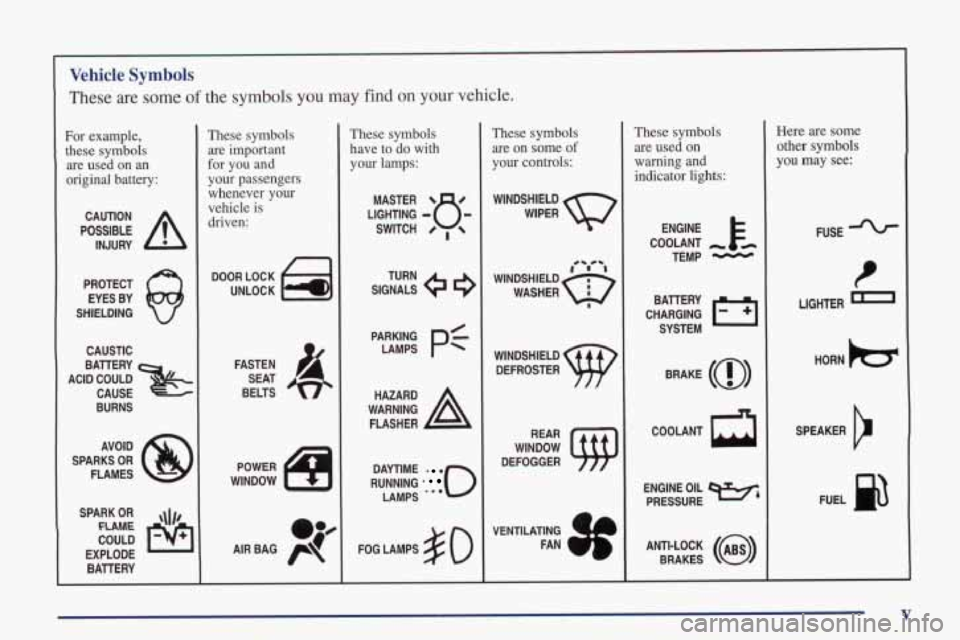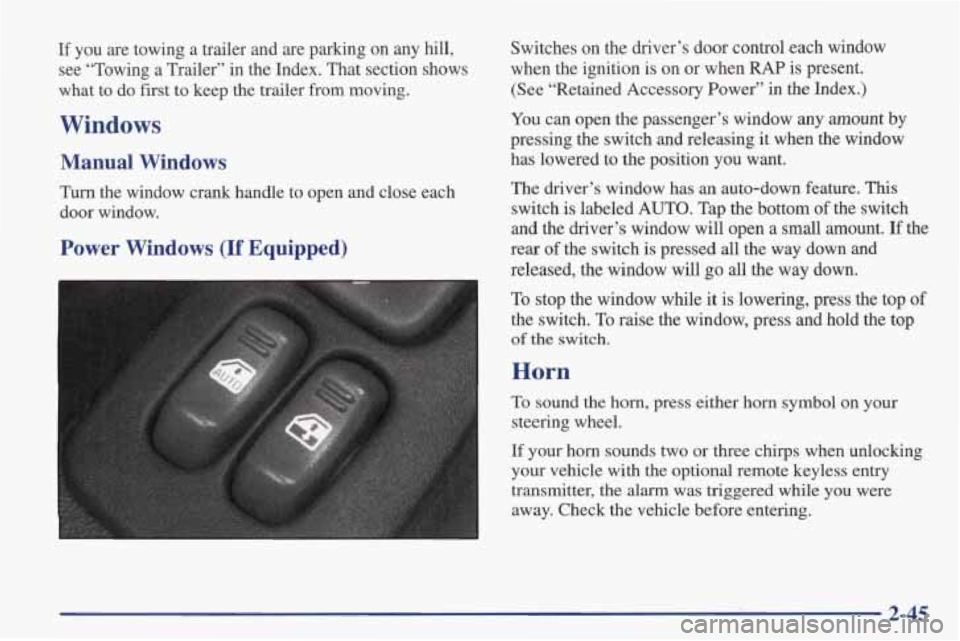window PONTIAC FIREBIRD 1998 Owners Manual
[x] Cancel search | Manufacturer: PONTIAC, Model Year: 1998, Model line: FIREBIRD, Model: PONTIAC FIREBIRD 1998Pages: 406, PDF Size: 18.23 MB
Page 6 of 406

Vehicle Symbols
These are some of the symbols you may find on your vehicle.
For example,
these symbols are used on an
original battery:
POSSIBLE A
CAUTION
INJURY
PROTECT EYES BY
SHIELDING
CAUSTIC
BURNS
SPARK
OR ,\I/,
COULD
FLAUE
EXPLODE BAllERY
These symbols are important
for you and
your passengers whenever your
vehicle
is
driven:
DOOR LOCK
UNLOCK
FASTEN SEAT
BELTS
e?
AIR BAG p
These symbols
have to do with
your lamps:
SIGNALS @ 9
TURN
PARKING
pf
LAMPS
RUNNING
' 0
DAYTIME * 0
LAMPS
FOG LAMPS
$0
These symbols
are on some of
your controls:
WIPER 9
WINDSHIELD
DEFROSTER
WINDOW
DEFOGGER
VENTILATING
'*
FAN '-d
These symbols are used on
warning and
indicator lights:
COOLANT
TEMP
-
CHARGING I-1
BATTERY
SYSTEM
BRAKE
(a)
COOLANT a
ENGINE OIL
PRESSURE
ANTI-LOCK
(@)
BRAKES
Here are some
other symbols
you may see:
FUSE
P
LIGHTER -
HORN )d.
SPEAKER
k
FUEL la
V
Page 33 of 406

How does an air bag restrain?
In moderate to severe fi-ontal or near-frontal collisions,
even
bdted occupants can contact the steering wheel or the
instrument panel.
Air bags supplement the protection
provided by safety belts.
Air bags distribute the force of
the impact more evenly over the occupant’s upper body,
stopping the occupant more gradually. But
air bags would
not help you in many types of collisions, including
rollovers, rear impacts and side impacts, primarily because an occupant’s motion is not toward those
air bags. Air
bags should never be regarded as an-g more than a
supplement to safety
belts, and then only in moderate to
severe fi-ontal or near-frontal collisions.
What will you see after an air bag inflates?
After an air bag inflates, it quickly deflates, so
quickly that some people may not even realize the air
bag inflated. Some components of the air bag
module
-- the steering wheel hub for the driver’s
air bag, or the instrument panel for the right front
passenger’s bag
-- will be hot for a short time. The
parts of the bag that come into contact with you may
be
warm, but not too hot to touch. There will be some
smoke and dust coming from vents
in the deflated air
bags.
Air bag inflation doesn’t prevent the driver from
seeing or from being able to steer the vehicle, nor does it
stop people from leaving the vehicle.
When an air bag inflates, there is dust in the air.
This dust could cause breathing problems for
people with a history
of asthma or other
breathing trouble.
To avoid this, everyone in the
vehicle should get out as soon as it is
safe to do so.
If you have breathing problems but can’t get out
of the vehicle after an air bag inflates, then get
fresh air
by opening a window or door.
In many crashes severe enough to inflate an air bag,
windshields are broken
by vehicle deformation.
Additional windshield breakage may
also occur from
the right front passenger air bag.
Air bags are designed to inflate only once. After they
inflate, you’ll
need some new parts for your air bag
system.
If you don’t get them, the air bag system
won’t
be there to help protect you in another crash.
A new system will include
air bag modules and
possibly other parts. The service manual for your
vehicle covers the need to replace other parts.
1-26
Page 44 of 406

A booster seat (F, G) is designed for children who
are about 40 to 60 lbs. (18 to 27 kg) and about
four to eight years of age. It’s designed to improve
the fit of the vehicle’s safety belt system. Booster
seats with shields use lap-only belts; however,
booster seats without shields
use lap-shoulder
belts. Booster seats can
also help a child to see out
the window.
1-37
Page 56 of 406

Section 2 Features and Controls
Here you can learn about the many standard and optional features on your vehicle, and inform\
ation on starting,
shifting and braking. Also explained are the instrument panel a\
nd the warning systems that tell you if everything
is
working properly -- and what to do if you have a problem.
2-2
2-4
2-6
2-11
2-13
2- 14
2-17
2-18
2-23
2-24
2-26 2-29
2-30
2-35
2-39
2-4 1
Keys
Door Locks
Remote Keyless Entry System
Hatch Theft
Content Theft-Deterrent System
(If Equipped)
PASS-Key@
I1
Feature Customization (If Equipped)
New Vehicle “Break-In”
Ignition Positions Starting Your Engine
Engine Coolant Heater (Canada Only)
Automatic Transmission Operation
Manual Transmission Operation
Shifting Into PARK (P)
(Automatic Transmission Only)
Shifting Out of PARK (P)
(Automatic Transmission)
2-4 1
2-42
2-42
2-43
2-44
2-45
2-46
2-46 2-52
2-55
2-57
2-58
2-62
2-69
2-76
2-79
Parking Your Vehicle (Manual Transmission)
Parking Over Things That Burn
Engine Exhaust
Running Your Engine While You’re Parked
(Automatic Transmission)
Parking Brake
Windows
Tilt Steering Wheel
Turn SignalMultifunction Lever
Exterior Lamps Interior Lamps
Mirrors Storage Compartments
%in Lift-off Roof Panels
(If Equipped)
Convertible
Top
Instrument Panel
Waming Lights, Gages and Indicators
2-1
Page 57 of 406

Keys
A CAUTION:
Leaving young children in a vehicle with the
ignition key is dangerous for many reasons.
A child or others could be badly injured or
even killed.
They could operate power windows
or other
controls or even make the vehicle move. Don’t
leave the keys
in a vehicle with young children.
2-2
Page 66 of 406

Hatch Hatch Release
A CAUTION:
I
It can be dangerous to drive with the hatch open
because carbon monoxide (CO) gas can come into
your vehicle. You can’t see or smell
CO. It can
cause unconsciousness and even death.
If you must drive with the hatch open or if
electrical wiring or other cable connections must
pass through the
seal between the body and
the hatch:
Make sure all windows are shut.
0 Turn the fan on your heating or cooling
system to its highest speed with the setting
on VENT. That will force outside air into
your vehicle. See “Comfort Controls” in
the Index.
instrument panel, open them all the way.
0 If you have air outlets on or under the
See “Engine Exhaust” in the Index.
Your door key opens the hatch from the outside. If your
vehicle has the Content Theft-Deterrent System and the
system is armed, opening the hatch this way will trigger
the alarm. First disarm the system or use the remote
keyless entry transmitter to open the hatch.
2-11
Page 68 of 406

Theft
Vehicle theft is big business, especially in some cities.
Although your vehicle has
a number of theft-deterrent
features, we know that nothing we put
on it can make it
impossible to steal. However, there
are ways you
can help.
Key in the Ignition
If you leave your vehicle with the keys inside, it’s an
easy target for joy riders or professional thieves
-- so
don’t do it.
When you park your vehicle and open the driver’s door,
you’ll hear a chime reminding you to remove your key
from the ignition and take it with you. Always do this.
Your steering wheel will be locked, and so will your
ignition.
If you have an automatic transmission, taking
your key out also locks your transmission. And
remember to lock the doors.
Parking at Night
Park in a lighted spot, close all windows and lock your
vehicle. Remember to keep your valuables out of sight.
Put them in a storage area, or take them with you.
Parking Lots
If you park in a lot where someone will be watching
your vehicle, it’s best to lock it up and take your keys.
But what
if you have to leave your ignition key?
0
0
0
0
0
0
If possible, park in a busy, well lit area.
Put your valuables in a storage area, like your
hatch or glove box.
Be sure to close and lock the
storage area.
Close
all windows.
Lock the glove box.
Lock
all the doors except the driver’s.
Then take the door key and remote keyless entry
transmitter with you.
2-13
Page 97 of 406

Parking Over Things That Burn Engine Exhaust
’ 1 CAUTION:
Things that can burn could touch hot exhaust
parts under your vehicle and ignite. Don’t park
over papers, leaves,
dry grass or other things that
can burn.
/d CAUTION:
Engine exhaust can kill. It contains the gas
carbon monoxide
(CO), which you can’t see or
smell.
It can cause unconsciousness and death.
You might have exhaust coming in if:
Your exhaust system sounds strange
0 Your vehicle gets rusty underneath.
0 Your vehicle was damaged in a collision.
0 Your vehicle was damaged when driving over
high points on the road or over road debris.
0 Repairs weren’t done correctly.
0 Your vehicle or exhaust system had been
If you ever suspect exhaust is coming into
your vehicle:
0 Drive it only with all the windows down to
Have your vehicle fixed immediately.
or
different.
modified improperly.
blow out any
CO; and
2-42
Page 100 of 406

If you are towing a trailer and are parking on any hill,
see “Towing a Trailer” in the Index. That section shows
what to do first to keep the trailer from moving.
Windows
Manual Windows
Turn the window crank handle to open and close each
door window.
Power Windows (If Equipped)
Switches on the driver’s door control each window
when the ignition is on or when
RAP is present.
(See “Retained Accessory Power” in the Index.)
You can open the passenger’s window any amount by
pressing the switch and releasing it when the window
has lowered to the position you want.
The driver’s window has an auto-down feature. This
switch is labeled AUTO. Tap the bottom of the switch
and the driver’s window will open a small amount.
If the
rear of the switch is pressed all the way down and
released, the window will
go all the way down.
To stop the window while
it is lowering, press the top of
the switch.
To raise the window, press and hold the top
of the switch.
Horn
To sound the horn, press either horn symbol on your
steering wheel.
If your horn sounds two or three chirps when unlocking
your vehicle
with the optional remote keyless entry
transmitter, the
alarm was triggered while you were
away. Check the vehicle before entering.
2-45
Page 104 of 406

Windshield Washer
There is a paddle with the word PUSH on it at the top of
the
turn signal lever. To spray washer fluid on the
windshield, just push the paddle for less than a second.
The washer will continue to spray until you release the
paddle. The wipers will clear the window and wipe
a
few more times before stopping or returning to the
previous setting. See “Windshield Washer Fluid” in
the Index.
A CAUTION:
I
In freezing weather, don’t use your washer until
the windshield is warmed. Otherwise the washer
fluid can
form ice on the windshield, blocking
your vision.
Cruise Control
With cruise control, you can
maintain
a speed of about
25 mph (40 km/h) or more
without keeping
your foot
on the accelerator.
This can really help on long trips. Cruise control does
not work at speeds below about
25 mph (40 km/h).
2-49